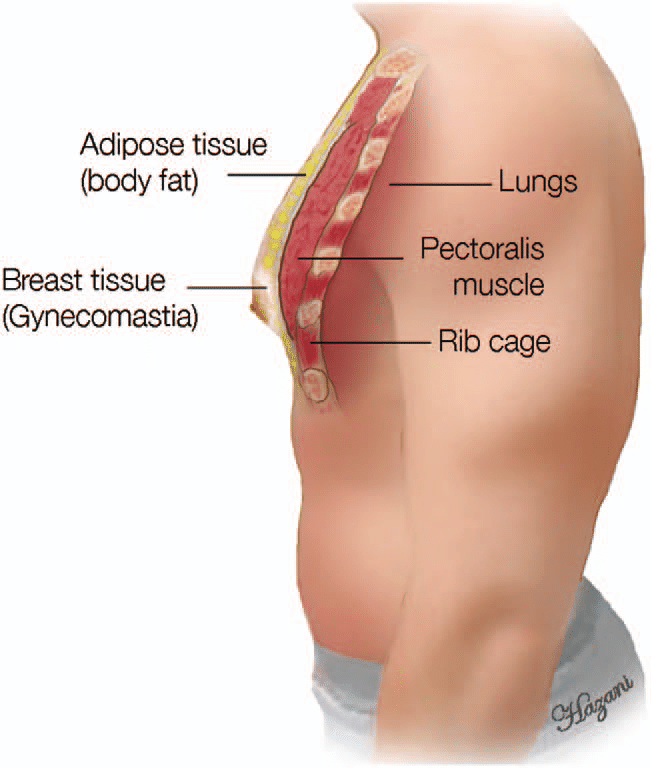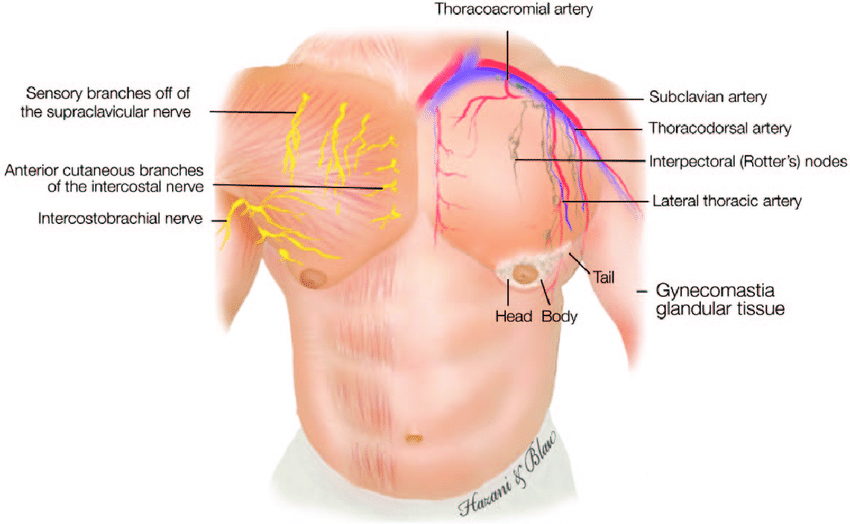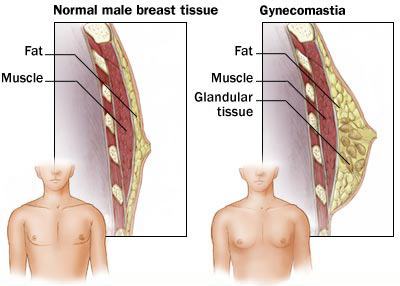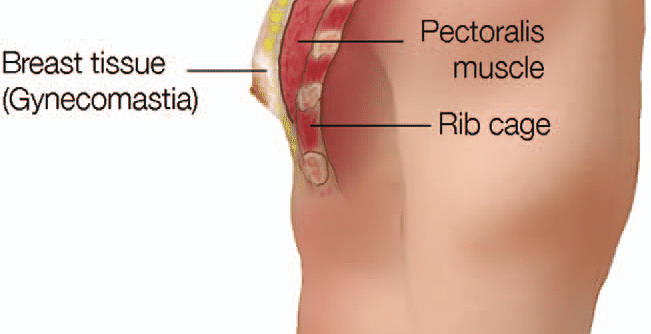Gynecomastia is the swelling of the breast tissue in males. This condition can affect one or both breasts. It that happens during puberty is caused by an imbalance of the hormones in the body. Males going through puberty, older men and newborns may develop gynecomastia due to normal hormone level changes, but other causes may also exist.
Although not a serious problem, coping with this problem can be tough. Those who have it may feel embarrassed due to their condition. They may also feel pain in their breasts. Gynecomastia may disappear on its own. If it doesn’t, surgery or medication may help.

Symptoms of Gynecomastia
Symptoms of gynecomastia include breast tenderness and inflamed breast gland tissue. The affected part may feel firm or rubbery. Both breasts are usually affected. In some cases, gynecomastia affects only one breast. One side might be larger than the other. Patients may fee breast sensitivity and tenderness as well.
Men with gynecomastia are 5 times more susceptible to developing male breast cancer than the general population. The hormonal changes that cause gyno such as lower androgen levels and higher estrogen levels increase the possibility of developing breast cancer. It’s important to know the difference between male breast cancer and this condition. Cancer usually affects only one side. It’s not necessarily centered on the nipple, but the affected side feels firm or hard. Other signs of cancer include nipple discharge and retraction, enlargement of the underarm lymph nodes and dimpling of the skin.
Diagnosis
Your drug and medical history will be assessed by your doctor. They will also ask what health problems run in the family. Your doctor will conduct a physical examination, which may include thorough assessment of your breast tissue, genitals and abdomen. Mammograms and blood tests are used to determine the cause of gynecomastia. Further testing may be required depending on the initial test results. These tests include MRI scans, tissue biopsies, CT scans and testicular ultrasounds.

Causes of Gynecomastia
- Hormonal Imbalance
Gynecomastia can occur when the levels of testosterone is lower than the amount of estrogen in the body. This decrease can be due to a condition that boosts your estrogen level or a health problem that reduce or prevent testosterone from doing its function. One of the factors that can upset the hormone balance is natural hormone changes. Estrogen is responsible for controlling female traits such as the growth of breasts. Testosterone controls muscle mass, body hair and other male traits.
Men also produce estrogen, but in smaller amounts. If their estrogen level is out of balance with their testosterone level or too high, they might develop this. Gynecomastia during puberty is common and usually goes away without treatment within 6 months to 2 years.
Male infants may also suffer from gynecomastia due to the effect of their mother’s estrogen. The inflamed breast tissue usually disappears within 2 to 3 weeks after birth. Gynecomastia is also common among men between the ages of 50 and 69.
- Health Conditions
Some health conditions affect the body’s normal balance of hormones. One of these conditions is hypogonadism. Conditions that inhibit normal production of testosterone like pituitary insufficiency and Klinefelter’s syndrome can be associated with this condition. Cirrhosis and liver failure cause hormonal fluctuations. Medications used for treatment of cirrhosis are also associated with development of male breasts.
Some tumors like those that affect the pituitary gland, testes or adrenal glands can produce hormones that alter the body’s hormone balance. Aging can also play a role in the development of male breasts. Hormonal changes occur as we age. Other possible causes of gynecomastia include starvation and malnutrition. When the body lacks proper nutrition, the levels of estrogen in the body remain constant. Testosterone levels, however, drop and this causes a hormonal imbalance. Gynecomastia may also develop once proper nutrition resumes.
Men who are going through regular hemodialysis due to kidney failure may also gynecomastia due to hormonal changes. Hyperthyroidism is also associated with gynecomastia. When you have this condition, your thyroid gland produces excessive amounts of thyroxine. This can cause a hormonal imbalance as well.
- Medications
Some medications can cause gynecomastia such as anabolic steroids and anti-androgens used for treatment of prostate cancer, prostate enlargement and other conditions. Examples of such medications include spironolactone, flutamide and finasteride.
Anti-anxiety medications like diazepam, antibiotics, tricyclic antidepressants, gastric motility medications, ulcer medications and heart medications can also trigger gynecomastia. AIDS medications may have the same effect. HIV-positive men who are getting HAART (Highly Active Antiretroviral Therapy) may also develop gynecomastia.
Cancer treatment such as chemotherapy may trigger gynecomastia as well. Some substances can cause male breast enlargement and these include alcohol, heroin, amphetamines, methadone and marijuana.
- Herbal Products
Lavender, tea tree and other plant oils used in lotions, shampoos and soaps have been associated with male breast development. This is most likely due to the weak estrogenic activity of these products.
Risk Factors
Older age, adolescence, certain health conditions like hormonally active tumors and kidney disease as well as use of androgens or anabolic steroids to improve athletic performance are some of the risk factors for gynecomastia.
Gynecomastia can cause emotional or psychological problems as it affects the sufferer’s self-image and confidence.
Conditions with Similar Symptoms
Your doctor will want to make sure that your condition is really gynecomastia. Some conditions cause similar symptoms such as a breast abscess or mastitis, breast cancer and fatty breast tissue. Some males have chest fat that looks like gynecomastia. This is known as false gynecomastia or pseudogynecomastia. It’s not the same as gynecomastia.
Pubertal gynecomastia usually disappears on its own. In rare cases, it may not go away naturally. When this happens, you need to seek your doctor for proper treatment. Gynecomastia that has lasted over 12 months or more may undergo fibrosis or scarring, making treatment with medications more difficult.
Gyno Treatment
Observation is usually preferred over treatment because gynecomastia often goes away naturally within 6 months. Treatment for gynecomastia usually includes stopping treatment and medications of existing health conditions or problems that cause inflamed breasts in men. No drug has been approved by the FDA for gynecomastia treatment. However, some medications have been used to treat gynecomastia such as clomiphene, which can be taken for 6 months.
Testosterone replacement has shown positive results in older men who have low testosterone levels. However, it’s not effective for males with normal testosterone levels.
Danazol reduces estrogen synthesis. It’s a synthetic testosterone derivative that inhibits pituitary secretion of FSH (follicle-stimulating hormone) and LH (luteinizing hormone) that direct the sex organs to generate hormones.
Tamoxifen has also been shown to reduce breast volume in men with gyno. However, it wasn’t able to completely get rid of all the affected breast tissue. This kind of therapy is often used for painful or severe gynecomastia.
Surgery
Medications are effective in the early stages of gynecomastia because scarring frequently occurs after about a year. When scarring has occurred, the only way to treat gynecomastia is through surgical removal of the affected tissue.
Breast reduction surgery or reduction mammoplasty has been used in long-term gynecomastia or severe cases of gynecomastia. It may also be used when drug therapies did not produce any positive results in restoring the appearance of the breasts. If you need surgery, you can check the gynecomastia cost and price here.
Liposuction may also be recommended by your doctor. The procedure involves removal of breast fast. The breast gland tissue itself is not removed. Another type of surgery that may be recommended is mastectomy. It involves removal of the breast gland tissue. Mastectomy may be done endoscopically. Only small incisions are made during the process. Mastectomy is less invasive and requires less recovery time.

How to Prevent Gynecomastia
Gynecomastia that is caused by hormonal fluctuations with aging or growth can’t be prevented. If you are taking medications known to trigger this condition, you should ask your doctor if there are other options. You can also reduce your risk by not using illegal drugs such as heroin, marijuana and amphetamines. Drink alcohol in moderation or avoid it completely. Doing so will help improve your overall health as well.
What to Do If You Have Gynecomastia?
Some people can feel depressed or embarrassed about their appearance. Many young men will have gyno during puberty, so don’t worry because you are not alone. There are also some tips that can help take your mind off of your condition. One of these is to maintain a healthy weight. Follow a healthy diet and exercise to get rid of excess pounds.
Wearing a thick shirt under your normal clothes or layers can also help. You can wear sweatshirts or a shirt that has a logo across the chest. Keep your shirt on when you swim. Weight lifting exercises can help develop the muscles in your chest, arms and back. If people ask about your condition, tell them that gynecomastia is quite common among men and will probably go away in a few months.
Build a support network by talking to your health care provider, trusted friend or family. This way, you don’t have to deal with this problem alone.
When to Visit a Doctor
Visit your doctor if you have nipple discharge or feel pain, swelling or tenderness in your breasts.


